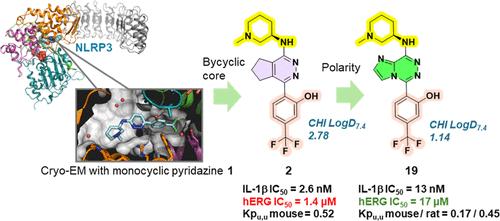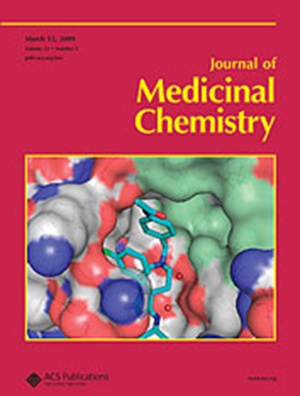Discovery of Potent and Brain-Penetrant Bicyclic NLRP3 Inhibitors with Peripheral and Central In Vivo Activity
IF 6.8
1区 医学
Q1 CHEMISTRY, MEDICINAL
引用次数: 0
Abstract
NLRP3 is a danger sensor protein responsible for inflammasome activation. This leads to pro-inflammatory cytokines release, like IL-1β, and pyroptosis, a regulated cell death. Mounting evidence associates excessive NLRP3 activation to neurodegenerative conditions, such as Alzheimer’s and Parkinson’s diseases. Thus, NLRP3 inhibitors could potentially provide therapeutic benefit for these disorders. We describe here the evolution of inhibitors relying on a pyridazine-based motif for their key interactions with NLRP3. A Cryo-EM structure helped optimizing protein–ligand complementarity. Subsequently, conformational NMR studies pointed the efforts toward 5,6-bicyclic cores that allowed a balance between brain penetration and undesirable properties, such as hERG inhibition. The effort culminated in compound 19, which showed moderate (mouse) to good (rat) brain penetration and was active at low dose in an LPS challenge model. Importantly, an earlier compound was active in a central neuroinflammation model providing a valuable proof of concept for NLRP3 inhibition.

求助全文
约1分钟内获得全文
求助全文
来源期刊

Journal of Medicinal Chemistry
医学-医药化学
CiteScore
4.00
自引率
11.00%
发文量
804
审稿时长
1.9 months
期刊介绍:
The Journal of Medicinal Chemistry is a prestigious biweekly peer-reviewed publication that focuses on the multifaceted field of medicinal chemistry. Since its inception in 1959 as the Journal of Medicinal and Pharmaceutical Chemistry, it has evolved to become a cornerstone in the dissemination of research findings related to the design, synthesis, and development of therapeutic agents.
The Journal of Medicinal Chemistry is recognized for its significant impact in the scientific community, as evidenced by its 2022 impact factor of 7.3. This metric reflects the journal's influence and the importance of its content in shaping the future of drug discovery and development. The journal serves as a vital resource for chemists, pharmacologists, and other researchers interested in the molecular mechanisms of drug action and the optimization of therapeutic compounds.
 求助内容:
求助内容: 应助结果提醒方式:
应助结果提醒方式:


